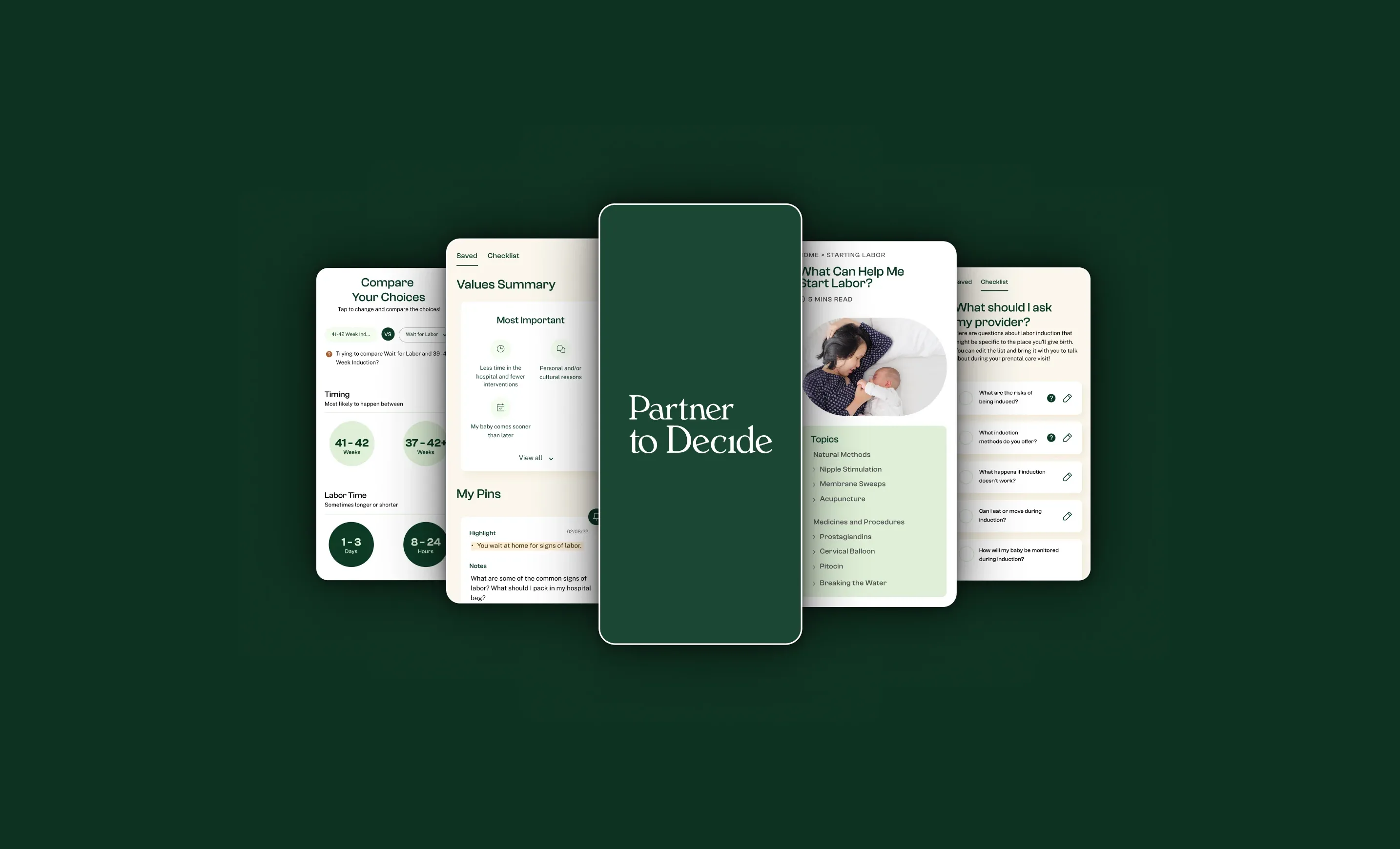
By
Jacob Phillips
A nonprofit empowering patient-centered care
Partner to Decide is a nonprofit that creates decision-aid tools to empower person-centered perinatal care. Its goal is to bridge the gap between guidelines and actual practice, making person-centered care more accessible for both providers and patients. We spoke with the founder, Ann Peralta, about her inspiration to start P2D and how she is furthering her mission with user-centered design.
Minor edits made for clarity.
Blink: What inspired you to create Partner to Decide?
Ann Peralta: The first time I was pregnant, I went through this process myself. We created P2D’s paper induction decision aid based on my experience of facing the decision of whether and when to have induction of labor. It wasn’t presented as much of a choice, and I felt like I had to educate myself.
As a doctoral student in public health, I had ridiculous access to scientific evidence and the ability to read it. With P2D, I want to work on solutions that make information about options and evidence accessible and easy to process, no matter who you are.
Tell us about P2D’s primary audience.
AP: Our tool’s main audiences are pregnant people, healthcare providers, and birth support workers, such as doulas.
- Pregnant people benefit the most as the tool simplifies complex information, helping them make informed decisions and avoid feeling coerced or pressured during the perinatal care process.
- Providers find it valuable because it makes their jobs easier by presenting complex information visually and in simple language. This makes it easier to communicate with patients and provide person-centered care.
- Birth support workers appreciate the tool’s concise summary of common topics, which enables them to assist their clients in navigating the decision-making process.
The tool’s focus on accessibility, including a lower reading level and multiple languages, benefits people with lower education levels and non-native English speakers, ensuring more equity in who "gets" to experience person-centered care.
What challenges were you facing with the paper decision aid that made you want to turn it into a digital platform?
AP: The main design challenge we faced with the paper version was that some pregnant people wanted more information on specific areas. If they were leaning towards labor induction, they wanted to see details for different methods. When we thought about including all the details on paper, we realized it would quickly go from a simple handout to an overwhelming book.
The same situation applies to term definitions on paper. Some people need more clarity on the terms mentioned (e.g., Cesarean section), while others are already familiar with specific language. The web version allows people to look up a specific term in one click or avoid the excess information if they don’t need a definition.
There’s also the convenience factor of going paperless. It’s not that institutions don’t use paper anymore, but for some institutions, challenges such as having the correct paper and printer size and stocking the correct languages based on location are barriers. The ability to toggle between languages on the web platform is also great for multilingual families.
“I hope this digital platform raises the bar for all tools in healthcare. These tools can be beautiful, interesting, informative, and evidence-based all at the same time.”
How did you hear about Blink’s pro bono program?
AP: The UX industry was new to me, but I knew Blink’s Head of Design, Ben Shown, and asked him for guidance on the original paper decision aid. That’s when he told me about the pro bono program. I was hesitant to apply and shocked when I was selected. I had just filed for 501(c)(3) status, so I was very early in building Partner to Decide.
It was a beautiful time to partner with Blink because we could also work on some brand elements. Getting this kind of investment early on felt really special because it did so much.
What was your experience like working with Blink?
AP: I was adamant that our research participant sample needed to be diverse — Black, Brown, people identifying as pregnant or postpartum, people on Medicaid insurance — and it was.
Blink quickly executed a national sample that provided incredible insights. We were able to build from there and add new user experience needs and wants. The team’s willingness to challenge ideas and propose innovative solutions demonstrated a true partnership. The final product speaks for itself, showcasing both beauty and functionality. Blink’s punctuality, open communication, flexibility, and the final product showed me their passion for the project.
Overall, my experience with Blink was great, and I hope this platform raises the bar for all healthcare tools. These tools can be beautiful, interesting, informative, and evidence-based.
Were there any user research insights that surprised you?
AP: Yeah! One of the coolest things that I talk about all the time came out of the research Blink did. Pregnant and postpartum people said their providers always asked what questions they had, but what the heck am I supposed to be asking? For whatever reason, that hadn’t come up when we were testing the paper-based tool.
That was a great insight, and it led us to build a feature within the web-based tool that didn’t exist in the paper version. After taking the values quiz, users can view and add to the provider questions we pre-populated. Then, email or download a PDF summarizing everything for them.
How did you introduce the digital platform to your users?
AP: I spent about a year trying to get the tool built pro bono. After many dead ends, I met the right person at the right time. She happened to be in charge of implementing projects related to the White House Maternal Blueprint. One of their goals is to empower pregnant people as primary decision-makers in their care, and the Blueprint calls out induction as an example of something that pregnant people should be the decision-makers on but often are not.
That initiative provided the funding to build the web prototype Blink designed and translate it into more languages. We launched the web-based tool in six languages in the first week of December 2023!





Congratulations on the official launch! How has adoption been so far?
AP: Website traffic has been steadily rising, averaging 600 to 800 monthly visits. Despite minimal SEO efforts, user interest and organic sharing have been the primary drivers of this growth.
The tool is also getting attention from larger institutions. Two months after its initial launch, it has already made an impact. A group of midwives in St. Paul, Minnesota, integrated the decision aid at Minnesota Community Care.
We’re also working with Boston Medical Center and UC San Diego Health to adopt it within their medical systems.
I’ve presented the web version at a few conferences, and we saw a lot of positive responses from attendees. The tool’s multilingual capabilities — currently supporting six languages — are soon expanding to include Arabic and Corin for a specific need in St. Paul. The positive reception and growing user base validate the tool’s effectiveness and potential for an even more widespread impact!
Where can we hear more from you about Partner to Decide?
AP: The Safer Births virtual maternal health fair around Black Maternal Health Week will have a workshop called “Options & Opinions: Informed Labor & Birth” on April 15, 2024, at 6 p.m. ET. They will highlight the decision aid as a concrete tool that is available now.



